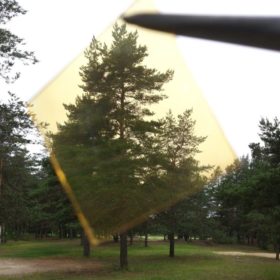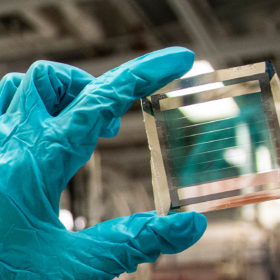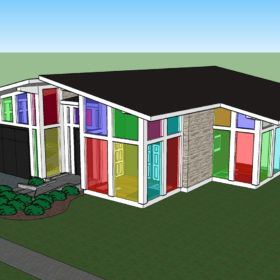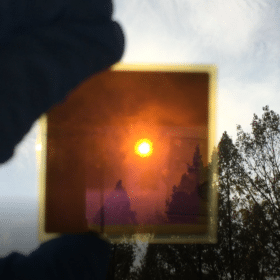Semi-transparent antimony trisulfide PV cell for solar window applications
The 5.5%-efficient cell was fabricated through a low-temperature, two-step manufacturing process that is compatible with existing window glass manufacturing technology. Cells made with 70nm antimony trisulfide films achieved the best fill factor of around 57%, while the highest power conversion efficiencies were achieved with films ranging from 70 to 100nm.
Quantum dot solar window with 3.6% efficiency
U.S. manufacturer UbiQD has developed a solar window with laminated glass and luminescent solar concentrators, based on copper indium sulfide and zinc sulfide quantum dots. It is now testing pilot installations in Nevada.
Semi-transparent organic solar cell for window applications
Developed by U.S. scientists, the 10%-efficient device is intended for applications in solar windows and promises efficiencies close to 15%. According to its creators, the cell retained 80% of its efficiency after 1,900 hours at 55 degrees Celsius.
Ever heard of photovoltachromics, the new tech for solar windows?
Researchers in China have developed a smart solar window tech based on a photovoltachromic device that is able to achieve a high pristine transmittance and to be self-adaptable to control indoor brightness and temperature. The device was assembled via a full solution process in an architecture incorporating glass, a fluorine-doped tin oxide (FTO) layer, a perovskite-based PV cell, an electrochromic gel, another FTO layer, and glass.
Nanoparticles enable completely clear, industry-sized solar windows
Australian company ClearVue Technologies says it has a fully transparent, scalable, industry-ready solar window in production. It claims that it’s now just 18 months away from cracking 5% efficiency, thanks to a research partnership.
Solar window based on luminescent solar concentrators
U.S. scientists have put luminescent solar concentrators in a windowpane to absorb certain light wavelengths and transmit them to solar cells. The concentrators are made of a conjugated polymer sandwiched between window layers.
Semitransparent bifacial CIGS cell with 10.5% efficiency
The solar cell was developed by Korean scientists for power-generating window applications. They built the device with transparent conducting oxide (TCO) rear contacts and a textured polydimethylsiloxane (PDMS) layer with light-scattering and antireflection properties.
BIPV windows viable only if they add soft value to buildings
Solar windows are only likely to reach commercial maturity when manufacturers consider how they can add “soft” value to buildings, as required by the construction industry. In order to increase this value, increasing their conversion efficiency will become less important, while understanding how to blend them into the existing value chain in the real estate business will be crucial.
New solar window tech from Australian startup
Australia’s ClearVue wants to push ahead with the development of its transparent solar glass technology. Construction is now beginning on a commercial-scale trial project.
Perovskite-based solar window tech from NREL
NREL’s new solar window darkens in the heat of the sun, producing electricity via embedded perovskite film. The tech is based on formamidinium-based metal halide perovskite, an inherently thermochromic material exhibiting significant optical changes.










